Proper backup lights for the JATAC - with remote control
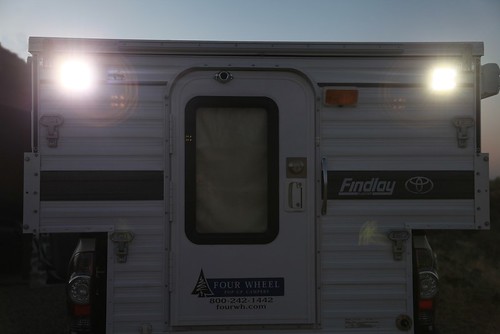 Brilliant 19-watt Grote LED floodlamps are optional on the Four Wheel Camper. Could they serve a dual purpose?
Brilliant 19-watt Grote LED floodlamps are optional on the Four Wheel Camper. Could they serve a dual purpose?
The sealed-beam automotive headlamp was introduced in the U.S. in 1939. In 1940, the government embraced the technology and required every car sold in this country to be equipped with identical 7-inch diameter incandescent headlamps—and for the next four decades, time essentially stood still. Not until 1978 did the U.S. legalize the superior halogen design (which had been used in Europe since the 1960s). Only in the last 15 years have further real advances been made in automotive headlamp technology, first with HID units and now, increasingly, with LED designs.
Rather peculiarly, though, our reversing lamps still appear to be stuck in 1940.
While a few manufacturers have begun installing LED backup bulbs, most remain incandescent. None that I’ve seen of either type matches the output of an average cheap single-AA LED flashlight—and this is with an entire automotive electrical system available to power it.
The situation is bad enough when you’re in a sedan trying to back out of a dark driveway without running over a pedestrian. It’s much, much worse if you find yourself too far down a narrow, rough four-wheel-drive route at night and need to turn around without going into the cactus or, somewhat worse, over the 50-foot cliff on the other side. I’m convinced not one Toyota, Land Rover, Jeep, or Mercedes engineer has ever been out testing a vehicle in the dark and found the need to engage reverse. Time after time in such a situation I’ve found myself trying to ride the brakes while doing so, because the brake lights are significantly brighter than the lights that are supposed to be showing me the way.
On my 1973 FJ40 I addressed the deficiency by installing a 50-watt Cibiè halogen fog lamp on the rear swing-away. Bam—problem solved. I can now reverse confidently out of a dicey situation without fear of making things worse.
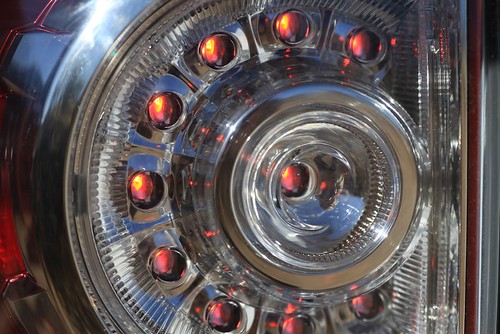 Nice LED brake lights on the Tacoma . . .
Nice LED brake lights on the Tacoma . . .
Our 2012 Tacoma’s running light and brake bulbs are all efficient, durable, and bright LEDs. (The brake lights add a safety factor: LED’s activate about two-tenths of a second faster than incandescent bulbs. If that doesn’t seem like much, consider that at 40 mph the car following you will travel 12 feet in that time, which could easily mean the difference between a non-event or a neck brace.)
Where was I? Right: The Tacoma’s reversing lights. I knew from experience they were . . . adequate, but didn’t work any better than the ones on our 2000 Tacoma. I couldn’t see what type they were by looking through the faceted lens, so I pulled the lamp assembly and the bulb, and, yep . . . 1940. What gives, Toyota?
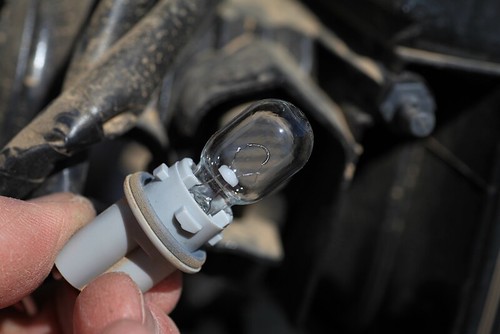 But what's with the cheap reversing bulb?
But what's with the cheap reversing bulb?
Ordinarily I would have gone online to look for upgraded bulbs, either a higher-wattage halogen replacement or an an LED conversion, although even this approach is somewhat limited by the stock reflector and lens. Other options include LED strips that mount on the license-plate frame (there are even compact HID reversing-bulb kits available with the potential to melt the plastic housing of the tail-lamp assembly).
However, since we have a Four Wheel Camper on our truck, and since on that camper we ticked the option box for a pair of high-mounted Grote 19-watt LED flood lamps that light up an area behind us most easily measured in acres, an obvious solution presented itself. Thanks to a tip from another FWC owner, Michael Doyle, I ordered a Cyron RC2-12 remote switch kit off Amazon for $25. The kit includes two key-chain remotes and a control box just a couple inches on a side, and advertises a 100-foot range.
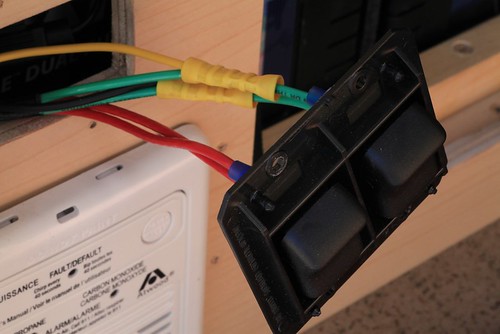 Given the low draw of the LED floodlamps and the protected location, I simply crimped the connections rather than soldering them.
Given the low draw of the LED floodlamps and the protected location, I simply crimped the connections rather than soldering them.
I pulled the switch assembly for the floodlamps and simply Siamesed the power and delivery-side wires of the remote into the existing wires to and from the manual switch. Another wire from the control unit went to an existing ground screw in the battery compartment behind the switches, and the unit itself attached to another existing screw. Voilà—we can now create reversing daylight from the driver’s seat anytime we need it.
(I know what you’re thinking, and yes: This would be a formidable weapon against tailgaters. In fact I fear it would be too formidable. The sudden appearance of lights this blinding could very well send said tailgater off the road—or into oncoming traffic. Tempting though . . .)
The Cyron remote can be used to switch any number of things, and can, for example, obviate the need to run switch wiring into the cab for driving lights. However, for high-amp loads you’d want to connect it through a relay rather than directly.*
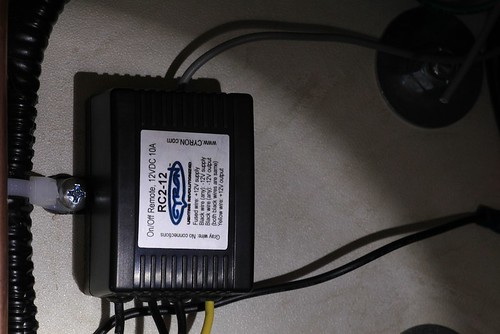 The compact control unit attached to an existing screw inside the camper's battery compartment. Grey wire on top is the antenna.
The compact control unit attached to an existing screw inside the camper's battery compartment. Grey wire on top is the antenna.
I’m still envisioning the perfect reversing lamp setup for a four-wheel-drive vehicle. Imagine a two-way system, with a properly bright light for urban driving and a switch that would activate extra-bright LED bulbs for use in the field. Sort of like the old city/country horn switch on the Jensen Interceptor of the 1970s, which activated a polite “toot” for urban use and an “out of my way” air blast for the country.
Of course, it’s unknown whether anyone actually bothered to ever switch to the city horn mode. So c’mon, someone just give us some good stock reversing lamps . . .
*This year at the Overland Expo, Baja Designs will conduct a demonstration on current lighting systems, covering the latest advances in HID and LED technology.
